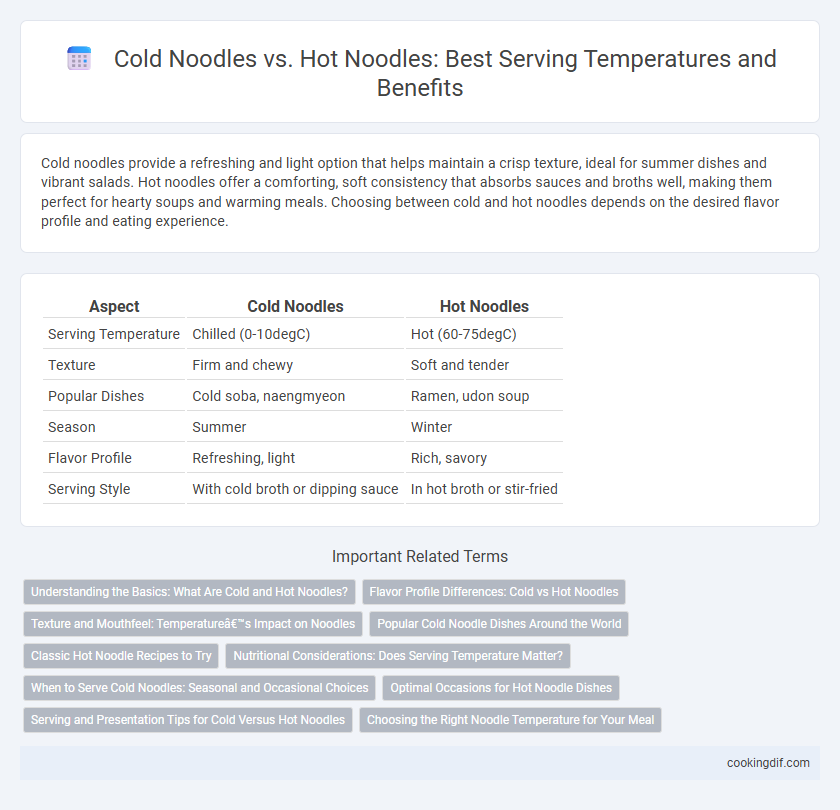Cold noodles provide a refreshing and light option that helps maintain a crisp texture, ideal for summer dishes and vibrant salads. Hot noodles offer a comforting, soft consistency that absorbs sauces and broths well, making them perfect for hearty soups and warming meals. Choosing between cold and hot noodles depends on the desired flavor profile and eating experience.
Table of Comparison
| Aspect | Cold Noodles | Hot Noodles |
|---|---|---|
| Serving Temperature | Chilled (0-10degC) | Hot (60-75degC) |
| Texture | Firm and chewy | Soft and tender |
| Popular Dishes | Cold soba, naengmyeon | Ramen, udon soup |
| Season | Summer | Winter |
| Flavor Profile | Refreshing, light | Rich, savory |
| Serving Style | With cold broth or dipping sauce | In hot broth or stir-fried |
Understanding the Basics: What Are Cold and Hot Noodles?
Cold noodles are typically blanched and cooled with ice water, offering a refreshing texture and suited for dishes like Korean naengmyeon or Japanese zaru soba, popular in summer. Hot noodles are served steaming, often in broths or stir-fried, enhancing flavors and comfort, seen in ramen or pho. The serving temperature directly impacts texture, flavor absorption, and cultural dining experience, making the choice between cold and hot noodles essential for recipe authenticity and sensory appeal.
Flavor Profile Differences: Cold vs Hot Noodles
Cold noodles exhibit a refreshing, firm texture that enhances subtle flavors and brightens ingredients like sesame or soy-based sauces, creating a crisp, clean taste experience. Hot noodles release aromatic steam that intensifies umami and deepens savory broths, enriching the overall flavor complexity with warmth and richness. Temperature distinctly transforms noodle flavor profiles, with cold noodles offering vibrant, crisp notes and hot noodles delivering bold, comforting depth.
Texture and Mouthfeel: Temperature’s Impact on Noodles
Cold noodles maintain a firm, chewy texture that enhances bite and offers a refreshing mouthfeel, while hot noodles soften, becoming tender and more pliable, creating a comforting sensation. Temperature significantly affects starch gelatinization and gluten structure, directly influencing the noodle's elasticity and surface smoothness. Serving temperature dictates textural contrast, with cold noodles providing a crisp snap and hot noodles delivering warmth and softness in every mouthful.
Popular Cold Noodle Dishes Around the World
Cold noodles offer a refreshing alternative to hot noodles, especially in warm climates or seasons, with popular dishes like Korean naengmyeon and Japanese zaru soba showcasing chilled, textured noodles served with flavorful, cooling toppings and dipping sauces. These cold noodle dishes emphasize the use of ingredients such as ice-cold broth, sesame seeds, cucumbers, and seaweed, enhancing the crisp, light eating experience distinct from the comforting warmth of hot noodles like ramen or pho. Global variations in cold noodle preparation highlight regional preferences for serving temperature, balancing taste, texture, and nutritional value to suit different culinary traditions and weather conditions.
Classic Hot Noodle Recipes to Try
Classic hot noodle recipes, such as spicy ramen or traditional pho, emphasize serving temperature to enhance flavor and texture, with steaming broths that infuse noodles with rich, aromatic qualities. Hot noodles tend to absorb sauces and spices more effectively, delivering a comforting and robust taste experience. Popular dishes like beef udon and chicken soba showcase how heat unlocks depth in seasoning and tenderizes ingredients, making them ideal for warming meals.
Nutritional Considerations: Does Serving Temperature Matter?
Cold noodles retain more resistant starch compared to hot noodles, which may aid in better blood sugar regulation and digestive health. Heating noodles breaks down some starches, increasing digestibility but potentially raising the glycemic index. Serving temperature influences not only texture and flavor but also the nutritional impact of noodles on metabolism and energy absorption.
When to Serve Cold Noodles: Seasonal and Occasional Choices
Cold noodles are ideal for serving during hot summer months, providing a refreshing and cooling meal option that helps combat heat and humidity. Popular in seasonal dishes like Korean naengmyeon or Japanese zaru soba, cold noodles are often featured at outdoor events, picnics, and light lunch menus. Serving cold noodles during warm weather occasions enhances texture and flavor appreciation, making them a perfect choice for balancing seasonal dining preferences.
Optimal Occasions for Hot Noodle Dishes
Hot noodle dishes are ideal for colder weather or comfort food cravings, providing warmth and soothing satisfaction. They complement hearty broths, rich sauces, and substantial ingredients that enhance the dining experience in fall and winter. Popular hot noodle options like ramen, udon, and pho are best served steaming to maximize flavor and texture.
Serving and Presentation Tips for Cold Versus Hot Noodles
Serve cold noodles chilled to maintain a firm texture and enhance refreshing flavors, often garnished with crisp vegetables or fragrant herbs for vibrant presentation. Hot noodles should be served immediately after cooking to retain their warmth and soft texture, plated with rich broths, sauces, or steamed vegetables to create a comforting visual appeal. Employ contrasting garnishes and appropriate dishware that accentuate temperature differences--such as cold noodles in glass bowls and hot noodles in ceramic bowls--for optimal sensory experience.
Choosing the Right Noodle Temperature for Your Meal
Cold noodles offer a refreshing texture and are ideal for dishes like soba or pasta salads, enhancing crispness and complementing light, tangy sauces. Hot noodles provide warmth that intensifies flavors and is perfect for hearty broths or stir-fried dishes, delivering comforting satisfaction. Selecting the right noodle temperature depends on balancing texture preferences and the type of accompanying ingredients to optimize meal enjoyment.
cold noodles vs hot noodles for serving temperature Infographic

 cookingdif.com
cookingdif.com